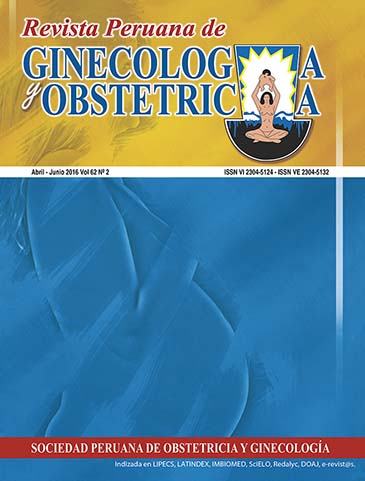Cervicovaginal interleukin-6 in the prediction of preterm delivery
DOI:
https://doi.org/10.31403/rpgo.v62i1900Abstract
Objective: To establish the usefulness of cervicovaginal interleukin-6 concentrations for the prediction of preterm delivery. Design: Case-control study. Setting: Hospital Central “Dr. Urquinaona”, Maracaibo, Venezuela. Participants: Patients with preterm delivery (group A), as cases, and pregnant women with term delivery (group B), considered as controls. Interventions: Cervicovaginal secretion samples were obtained from both the external cervical os and vaginal fornix between 24 and 28 weeks of pregnancy. All patients were followed until delivery. Main outcome results: General characteristics, cervicovaginal interleukin-6 concentrations, and prognostic efficacy. Results: Mean gestational age at measurement of interleukin-6 cervicovaginal concentrations was 26.2 +/- 1.1 weeks in group A and 25.9 +/- 1.1 weeks in group B (p = ns). There were no significant differences in maternal age, body mass index and history of preterm labor (p = ns). Group A patients presented higher cervicovaginal interleukin-6 concentrations (195.8 +/- 74.4 pg/mL) than group B (123.4 +/- 69.6 pg/mL) (p < 0.0001). A cut-off value of 150 pg/dL had a value under the curve of 0.75 and presented a sensitivity of 63.4%, a specificity of 62.5%, a positive predictive value of 13.5% and a negative predictive value of 94.8%. Conclusion: Cervico-vaginal interleukin-6 concentrations appeared useful in the prediction of preterm delivery.Downloads
Download data is not yet available.
Downloads
Published
2016-07-12
How to Cite
Reyna Villasmil, E., Mejia Montilla, J., Reyna Villasmil, N., Torres Cepeda, D., Santos Bolívar, J., & Fernández Ramírez, A. (2016). Cervicovaginal interleukin-6 in the prediction of preterm delivery. The Peruvian Journal of Gynecology and Obstetrics, 62(2), 175–181. https://doi.org/10.31403/rpgo.v62i1900
Issue
Section
Artículos Originales
















